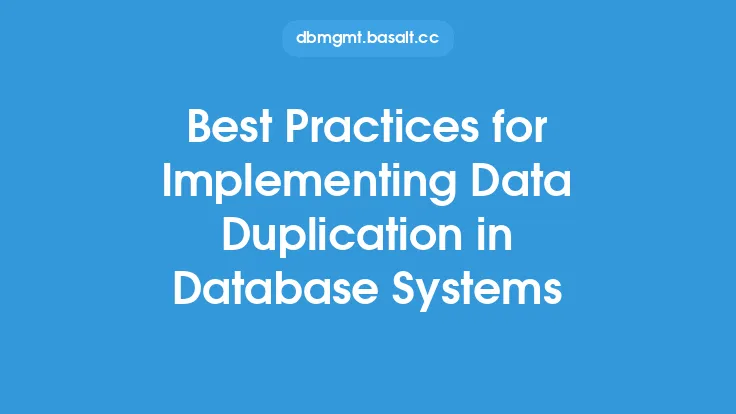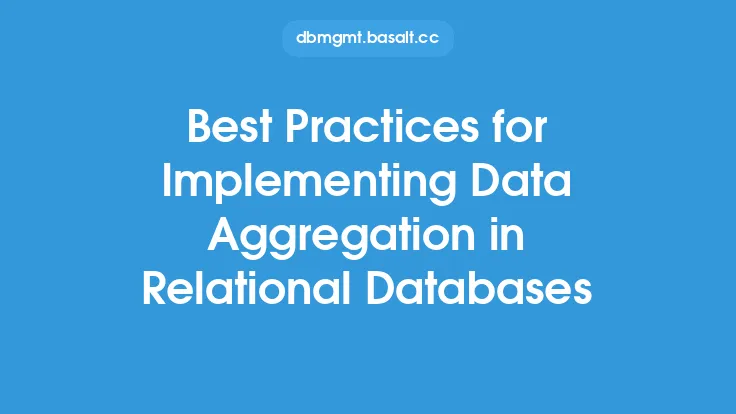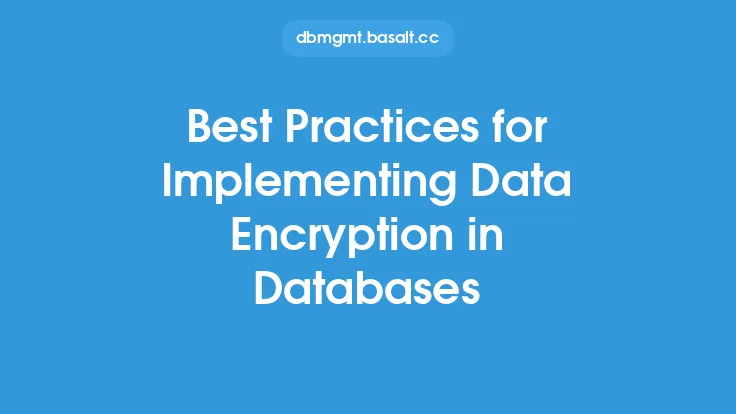When implementing a database schema, it's essential to follow best practices to ensure the schema is well-structured, scalable, and maintainable. A well-designed database schema is critical to the overall performance and reliability of the database, and it plays a crucial role in supporting the application or system that relies on it. In this article, we'll explore the key best practices for implementing database schemas, including planning, design, implementation, and testing.
Planning and Design
Before implementing a database schema, it's crucial to plan and design it carefully. This involves identifying the requirements of the application or system, defining the data models, and determining the relationships between different data entities. A well-planned database schema should be able to support the current and future needs of the application, and it should be flexible enough to accommodate changes and updates.
One of the key considerations during the planning and design phase is data normalization. Data normalization involves organizing the data in a way that minimizes data redundancy and dependency, and it helps to ensure that the data is consistent and accurate. There are several normalization techniques, including first normal form (1NF), second normal form (2NF), and third normal form (3NF), each of which provides a higher level of normalization.
Another important consideration is data denormalization. While data normalization is essential for ensuring data consistency and accuracy, it can sometimes result in slower query performance. Data denormalization involves intentionally deviating from the normalization rules to improve query performance, and it's often used in situations where query performance is critical.
Implementation
Once the database schema has been planned and designed, it's time to implement it. This involves creating the database tables, indexes, views, and other database objects, and it requires a good understanding of the database management system (DBMS) being used.
One of the key best practices during the implementation phase is to use meaningful and consistent naming conventions. This includes using descriptive table and column names, and it helps to ensure that the database schema is easy to understand and maintain.
Another important consideration is indexing. Indexing involves creating data structures that improve query performance by allowing the database to quickly locate specific data. There are several types of indexes, including clustered indexes, non-clustered indexes, and full-text indexes, each of which is suited to specific use cases.
Testing and Validation
After the database schema has been implemented, it's essential to test and validate it to ensure that it meets the requirements of the application or system. This involves creating test data, running test queries, and verifying that the results are accurate and consistent.
One of the key best practices during the testing and validation phase is to use automated testing tools. Automated testing tools can help to ensure that the database schema is thoroughly tested, and they can reduce the risk of human error.
Another important consideration is data validation. Data validation involves checking the data to ensure that it conforms to the expected format and range, and it helps to prevent data errors and inconsistencies. There are several data validation techniques, including check constraints, default values, and triggers, each of which provides a different level of validation.
Maintenance and Updates
After the database schema has been implemented and tested, it's essential to maintain and update it regularly. This involves monitoring the database performance, updating the database statistics, and making changes to the database schema as needed.
One of the key best practices during the maintenance and update phase is to use version control systems. Version control systems can help to track changes to the database schema, and they can provide a history of changes that can be used to revert to previous versions if needed.
Another important consideration is backup and recovery. Backup and recovery involve creating copies of the database and restoring them in case of a failure or data loss. There are several backup and recovery techniques, including full backups, incremental backups, and transaction log backups, each of which provides a different level of protection.
Conclusion
Implementing a database schema requires careful planning, design, implementation, testing, and maintenance. By following best practices, such as data normalization, meaningful naming conventions, indexing, automated testing, data validation, version control, and backup and recovery, you can ensure that your database schema is well-structured, scalable, and maintainable. Remember to stay flexible and adapt to changing requirements, and don't be afraid to seek help when needed. With the right approach and techniques, you can create a database schema that supports the needs of your application or system and provides a solid foundation for future growth and development.





